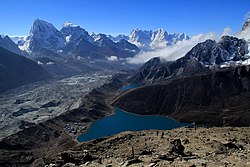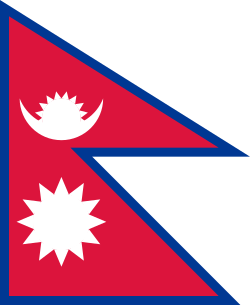Portal:Nepal
स्वागतम् / Welcome to the Nepal Portal
|
List of Good articles
|
|---|
Selected picture -

The Ganges, is a trans-boundary river of Asia which flows through India and Bangladesh. The 2,525 km (1,569 mi) river rises in the western Himalayas in the Indian state of Uttarakhand, and flows south and east through the Gangetic Plain of North India into Bangladesh, where it empties into the Bay of Bengal. It is the third largest river by discharge.
Categories
Selected biography -
Aniko, Anige or Araniko (Nepali: अरनिको, Chinese: 阿尼哥; 1245–1306) was one of the key figures in the arts of Nepal and the Yuan dynasty of China, and the artistic exchanges in these areas. He was born in Kathmandu Valley during the reign of Abhaya Malla. He is known for building the White Stupa at the Miaoying Temple in Beijing. During the reign of Jayabhimadeva, he was sent on a project to build a golden stupa in Tibet, where he also initiated into monkhood. From Tibet, he was sent further to northern China to work in the court of the emperor Kublai Khan, the founder of the Yuan dynasty, where he brought the trans-Himalayan artistic tradition to China. Araniko led a team of 80 artists to China proper and Tibet to make a number of pagoda-style buildings. In his later life, he renounced monkhood and started a family.
To some confusion in translation, his name is variously written as Arniko or Araniko in old texts. A mistake made by Baburam Acharya ascribed his Sanskrit name as Balabahu. However, later he contends that Aniko might possibly be the Chinese pronunciation for the Sanskrit name Aneka. It is also plausible that his name could mean AA Ni Ka, meaning "respectable brother from Nepal". (Full article...)
Selected fare or cuisine -
Chunlā (Newar: चुंला, "ground meat") is a traditional meat dish of the Kathmandu Valley in Nepal. It is meat finely chopped by a chopping knife or meat grinder. Chunlā is a popular dish in Newar cuisine and is similar to Qeema found in other parts of South Asia. (Full article...)
List of fare/cuisine articles
|
|---|
Did you know -
- ... that Binod Chaudhary is the first Nepali to be listed on Forbes's billionaire list?
- ... that Nepal declared a national day of mourning after the 2019 Taplejung helicopter crash?
Wiki Loves Nepal
   
|
Wiki Loves Earth is an international photographic competition to promote natural heritage sites around the World through Wikimedia projects (mainly Wikipedia and Wikimedia Commons).
- 2018 • 2017 • 2016 • 2015 • 2014 • More information • Main category page

Wiki Loves Monuments is an international photographic competition to promote cultural monuments around the World through Wikimedia projects (mainly Wikipedia and Wikimedia Commons.
- 2017 • 2016 • 2015 • 2014 • 2013 • More information • Main category page
Provinces
General images -
The following are images from various Nepal-related articles on Wikipedia.
Topics
Related portals
Indian Subcontinent
Other countries
Recognized content
Associated Wikimedia
The following Wikimedia Foundation sister projects provide more on this subject:
-
Commons
Free media repository -
Wikibooks
Free textbooks and manuals -
Wikidata
Free knowledge base -
Wikinews
Free-content news -
Wikiquote
Collection of quotations -
Wikisource
Free-content library -
Wikiversity
Free learning tools -
Wikivoyage
Free travel guide -
Wiktionary
Dictionary and thesaurus































































